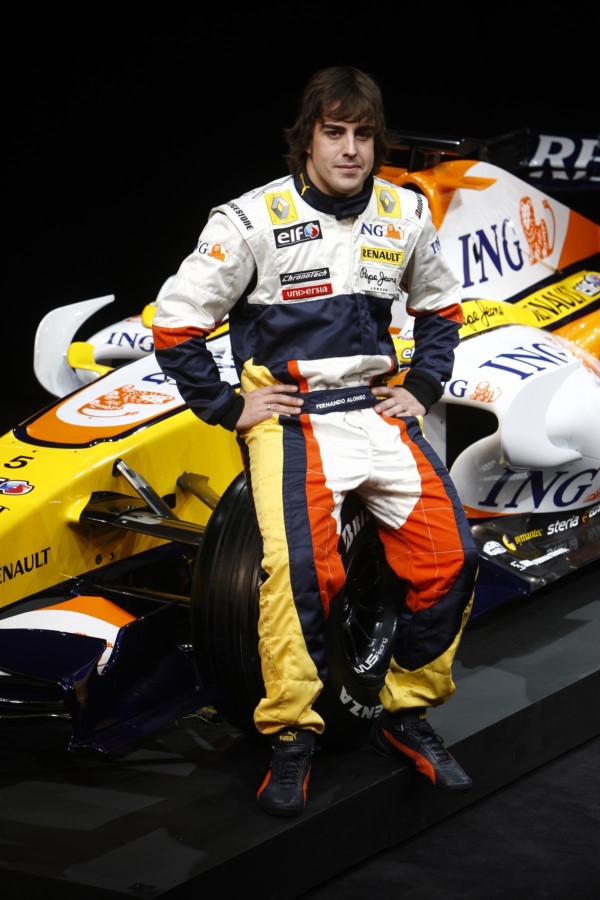Renault launches 2008 F1 car
 |
| Alonso with his new mount |
Renault launched their 2008 season on Thursday with an official unveiling ceremony for their new car, the R28, and their revised driver line-up of Fernando Alonso and Nelson Piquet Jr. It’s a combination the former champions hope will return them to the sharp end of the grid this year after a disappointing 2007.
All was revealed at Renault’s communication headquarters in Paris in front of 500 guests, including Renault President and CEO Carlos Ghosn and Michel Tilmant, Chairman of the Executive Board of the team’s title sponsors, the ING Group.
Commenting on Renault’s aggressive aims for their 2008 recovery, the team's President Bernard Rey said: "We expect to see the team back in its normal place, fighting at the front of the field. This is the target the team has set for the new car. On the technical side, everybody has worked hard to overcome the problems encountered last year. On the driver front, Fernando Alonso's return was an important boost. There is optimism inside the team and within Renault."
 |
| Renault R28 |
Renault say the R28, which made its track debut at Valencia last week, is a blend of new solutions and proven technology, drawing on the strengths of its predecessor but eliminating its weaknesses. The team have moved to a zero-keel layout for the car's front end, part of a new design philosophy aimed at extracting maximum performance from Bridgestone’s tires, an area that caused Renault particular concern with the R27 last year.
"We have put the problems from 2007 behind us and in terms of the car design, we have looked at the problem afresh," said technical director Bob Bell. “The team pushed very hard in all areas, and particularly on the aerodynamics. The front end of the car has come in for special attention with a brand new front wing and the front suspension. The rear end has also been heavily reworked, and we haven't neglected the basics.
“The car ran reliably in its first test, and we made encouraging progress on performance development last week. We are confident that the advances we have seen in the wind tunnel will be reflected on track."
Having won back to back title doubles in 2005 and 2006, Renault finished a distant third in last year's constructors' standings, 153 shy of champions Ferrari.
 |
| Front nose |
Renault F1 R28 Technical Description
Following the ING Renault F1 Team’s disappointing performance in 2007, the new R28 marks a change in design philosophy aimed at extracting maximum performance from the Bridgestone control tires – and redressing the shortcomings of the ill-starred R27. The R27 was a conservative evolution of its predecessors, whose philosophy of rearward weight distribution and aero balance was perfectly tuned to the characteristics of the Michelin tires used until the end of 2006. Testing during late 2006 and the early part of 2007 confirmed that major changes would be required to get the most from the standard Bridgestone tires; this was further compounded by correlation problems between the wind tunnel and track performance, which caused unpredictable and inconsistent handling in the early part of the season.
 |
| 2008 Renault drivers (L to R) Piquet, Grosjean, Di Grassi, Alonso |
Renault soon got down to work analyzing and correcting its problems, a process it had completed by mid-season, but decided early in 2007 not to manufacture a ‘B-spec’ version of the R27 – in order to avoid compromising preparations for 2008. With this in mind, the team ceased development of the R27 during August in order to focus on a major change in concept for the new car. Launched later in January than previous Renaults, the R28 has benefited from the maximum possible development time in the wind tunnel and, in the words of Bob Bell, it is “much less evolutionary" than its predecessors. The car’s most obvious architectural difference is the adoption of a “zero-keel" front suspension mounting. 2007 was the first season in which a zero keel car won the championship and although the team had investigated the solution on numerous occasions, this was the first time that it offered real aerodynamic gains in the tunnel. The team says that the configuration opened up new aerodynamic development paths, rather than being a net gain in itself, and it has worked hard to retain the forgiving mechanical configuration of previous cars in spite of the change.
Renault F1 R28 Technical Specifications
Chassis: Molded carbon fiber and aluminum honeycomb composite monocoque, manufactured by the
Renault F1 Team and designed for maximum strength and stiffness with minimum weight.
RS27 V8 engine installed as a fully-stressed member.
Front suspension: Carbon fiber top and bottom wishbones operate an inboard rocker via a pushrod system. This is connected to a torsion bar and damper units which are mounted at the front of the monocoque. Zero-keel design for front suspension mounting in order to optimize front end aerodynamic performance.
Rear suspension: Carbon fiber top and bottom wishbones operating vertically-mounted torsion bars and horizontally-mounted damper units mounted on the top of the gearbox casing.
Transmission: Seven-speed semi-automatic titanium gearbox with one reverse gear. “Quickshift" system in operation to maximize speed of gearshifts.
Fuel system: Kevlar-reinforced rubber fuel cell by ATL.
Cooling system: Separate oil and water radiators located in the car's sidepods and cooled using airflow from the car's forward motion
Electrical: MES-Microsoft standard Electronic Control Unit.
Braking system: Carbon discs and pads (Hitco); calipers by AP Racing.
Cockpit: Removable driver’s seat made of anatomically formed carbon composite, with six-point harness seat belt. Steering wheel integrates gear change and clutch paddles.
Car dimensions and weight
Front: track 1450 mm
Rear: track 1400 mm
Overall length: 4800 mm
Overall height: 950 mm
Overall width: 1800 mm
Overall weight: 605 kg, with driver, camera and ballast
